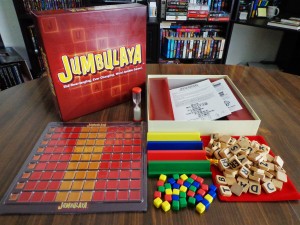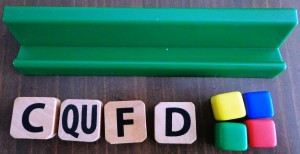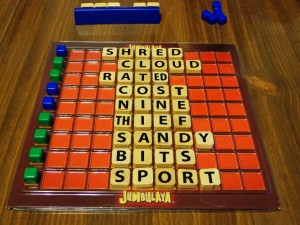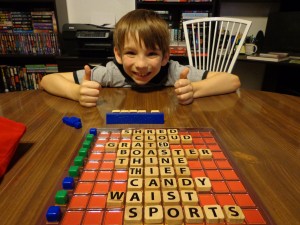No matter how hard I try, I can’t stop calling this game jambalaya. Since I have a habit of butchering its name while describing this game to others, everyone ends up getting the impression that I’m not only out of my gourd, but also have a crippling creole addiction.
Jumbulaya is a game that challenges players to come up with words that would be extremely difficult for other players to build on. The game board consists of nine lines, each with their own word that will change and expand as the game goes on. Players will be laying claim to these lines as they change those words, with the ultimate goal of retaining ownership of those lines for endgame scoring. Let’s take a quick look at the game and how it is played before heading into the review.
Components
Letter Tiles – Players will be placing and/or rearranging these wooden letter tiles on the board during their turn.
Tile Trays – Each player will receive a tile tray to hold the letters that make up their “hand.”
Line Markers – Players will be placing these next to the word that they’ve changed to claim ownership of that line.
Setup & Gameplay
Each player picks a color and receives a tray, player markers, and five random tiles. Twenty-seven random tiles are drawn from the bag as well and are placed on the board, three per line, on the gold spaces.
On a player’s turn, they will choose one of the nine horizontal lines and do one of the following:
1. Shuffle the existing letters to create a new word.
2. Add up to two tiles from their tray to create a new word and replenish their hand from the letter pool.
3. Trade up to two tiles from their tray with the same number of tiles in the word to create a new word.
4. Any combination of shuffling, adding, or trading tiles, so as long as no more than two tiles are added or traded.
5. Forgo changing that word to exchange their tiles on their rack (some or all) for new tiles.
6. Pass.
Players take turns shuffling and adding to words, exchanging out their player marker with the one currently present every time they do. They will be attempting to lay claim to as many lines as they can and keep their markers there by coming up with words that are hard to change.
The game ends when someone calls “Jumbulaya”, which can only happen if certain game conditions are met. For one, all of the nine lines must contain valid words and at least one of them must be at least seven tiles long. A Jumbulaya can be called after those conditions are met AND a player discovers a seven, eight, or nine letter word that runs vertically, starting from the top. The tiles don’t have to be in the same column.
After that, players receive their scores. Points are awarded per line, to the person who has a player marker on them. The longer the word, the more points that are awarded. The player who announced the Jumbulaya also receives points, and bonuses are awarded to players for certain circumstances. Whoever has the most points at the end of it all wins!
The game can also end if someone manages to claim all nine lines at once during the game…this person automatically wins, Jumbulaya or not.
While I was unable to find the manual on the Legendary Games website, I found a scanned version, along with an informative (and funny) video that should help add to the above overview.
The Review
Having recently reviewed “You’ve Been Sentenced”, I was excited to play yet another educational game that encouraged the kids to expand on their vocabulary. Anything that forces the kids to think whilst prepping them for the future gets an “A+” in my book. The ability to add, trade, and shuffle tiles (and in combinations thereof) on any given word helps to keep a player from getting too stumped. I really appreciate the amount of flexibility that players are given in order to come up with new words.
This game reminds me a little of Upwords and Scrabble, though it is unique enough to set itself apart in many ways. Claiming a line with a player marker is a fun mechanic, forcing players to think outside of the box. Swapping out a letter for a letter to turn “cat” into “bat” might be legal, but it’s still an easy target to be expanded on. Although, some players may swap out tiles just so that they can gather the letters they need to make a longer word down the line.
The components are sturdy and well made. I like how the plastic cover on the board keeps the tiles in check so that I can swivel the board around to face the current player. The rules are also flexible enough to where players can come up with their own variants, making the age limit on the box seem a bit high. My eleven year old, Vinnie, did just fine and I was more than happy to work with him once the words began to get bigger. Parents can adjust the seven letter word requirement to say, five letters, for a shorter, easier game with their young ones. As such, I think the age limit can be lowered to about eight years and up, though parents will have to use their best judgement and coach them when appropriate.
Vinnie and I had a blast playing this game. I put the sand timer aside and let him work out words at his own pace and helped him where he needed it. I found that I was able to help him in his spelling at the same time, so from a dad’s point of view, everyone ended up being a winner. I highly recommend Jumbulaya as it will appeal to a wide range of people…family, friends, kids, adults, you name it.
Final Verdict: 10/10
—




